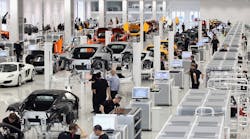In the U.S., and other advanced economies, businesses will face serious labor shortages over the next fifteen years.
A report, “From Not Enough Jobs to Not Enough Workers”, released on Sept. 2 by the Conference Board, forecasts the impact of aging populations to compound rapidly as increasing numbers of baby boomers depart workforces.
"Mature economies are facing a historical turning point: for the first time since World War II, working-age populations are declining," said Gad Levanon, director of Macroeconomic Research at The Conference Board. "The global financial crisis and its aftermath—stubbornly high unemployment in many countries—have postponed the onset of this demographic transformation, but will not prevent it from taking hold.
“Companies in the U.S., Europe, and elsewhere must begin planning now for an environment in which difficulties recruiting and retaining workers will make it significantly harder to control labor costs without losing labor quality."
While current labor markets in mature economies are not particularly tight overall—wage growth and labor turnover both remain below prerecession levels—this aggregate picture conceals huge variation between countries, with rapid reversal from labor surplus to shortage in many, according to the group.
Already, Canada, Germany, Japan, and South Korea have reversed any effects of the recession and fallen below their natural rate of unemployment.
The United States and United Kingdom are likely to follow in 2014–15, while countries like Australia, Sweden, Belgium, and Denmark will cross the threshold by 2016–17. The hardest-hit European economies—Greece, Spain, Italy, and Portugal—as well as France will likely retain slack labor markets for longer, with natural rates of unemployment unlikely to be reached until after 2018.
Occupational data from the United States indicates that future labor shortages will cluster around three major categories of concern:
- Skilled labor occupations. These jobs typically require more than a high-school education, but not a bachelor's degree. The primary driver of shortages here is not increased demand—employment growth is expected to be low in the coming decade—but instead a rapidly shrinking supply of young people entering these fields as increasing numbers retire. Skilled labor occupations most at risk include water and wastewater treatment plant and system operators, crane and tower operators, transportation inspectors, and construction and building inspectors.
- STEM occupations. U.S. policymakers have long been concerned about shortages in science, technology, engineering, and mathematics, but many of these fields rank surprisingly average in a national context. Moderating the risk of shortages is the relativelyhigh number of young entrants compared to baby-boomer retirees, as well as the large proportion ofnew immigrants in STEM jobs.
Moreover, strong productivity growth means that output will continue to expand in areas like information technology, telecommunications, and high-tech manufacturing even as workforces in these jobs are expected to shrink. Nevertheless, certain STEM fields—including mathematical science, information security, and civil, environmental, biomedical, and agricultural engineering—do face significant shortages.
"Our extensive database of occupational data points us to the U.S. industries most at risk of labor shortages," said Levanon. "Topping the list are: healthcare, including hospitals and nursing facilities; transportation industries, including ground passenger, water, and rail transport; utilities; social assistance; and mining and construction."
- Health-related occupations. The same aging of the U.S. population that will curtail working-age population growth to as low as 0.15 percent by 2030 is also driving up demand for medical workers. At the same time, high education and experience requirements limit entry into the job market. The result is a dearth in many healthcare professions, including occupational therapy assistants, physical therapists and therapist assistants, nurse practitioners and midwives, and dental hygienists. Among doctors, optometrists and podiatrists are the specialists most at risk of shortage, with the general physicians and surgeons category not far behind.
"Our database of occupational data points us to the U.S. industries most at risk of labor shortages," said Levanon. "Topping the list are: healthcare, including hospitals and nursing facilities; transportation industries, including ground passenger, water, and rail transport; utilities; social assistance; and mining and construction."
To determine long-term trends, From Not Enough Jobs to Not Enough Workers introduces a Labor Shortage Index which combines current labor-market tightness with future demographic developments factors to predict the likelihood of countries experiencing labor shortages in 2025:
- Germany faces the largest risk of labor shortages among 32 countries compared, based on negative projected labor-force growth and an unemployment rate already below the natural level.Germany's highly integrated Central European neighbors—includingHungary,Poland,Austria,Slovakia, and the Czech Republic—face risks nearly as high.
- Despite the severity of the economic crisis in Mediterranean countries, they may in fact see labor shortages by 2025. With minimal productivity growth and a large working-age population decline projected,Italy is at particularly high risk.
- The Asia-Pacific picture is mixed. Already experiencing one of the world's tightest labor markets, Japan faces similar demographic pressures as Germany in the decade ahead. High productivity growth should moderate the risk in South Korea.
- The risk of labor shortages in the United States will be moderate in a global context, as its working-age population grows minimally—but faster than most mature economies due to immigration. Risks in the U.K.,France, and Canada will be broadly comparable to the U.S.











